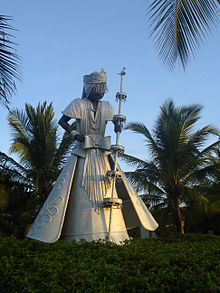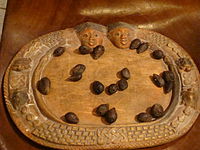- Obatala
-
 Statue of Obàtálá in Costa do Sauípe, Bahía.
Statue of Obàtálá in Costa do Sauípe, Bahía.
In the religion of the Yoruba people, Obàtálá is the creator of human bodies, which were supposedly brought to life by Olorun's breath. Obàtálá is also the owner of all ori or heads. Any orisha may lay claim to an individual, but until that individual is initiated into the priesthood of that orisha, Obàtálá still owns that head. This stems from the belief that the soul resides in the head.
Contents
Obatala in Yoruba religion
In Ile Ife: the dying and rising god
According to mythical stories Obatala is the eldest of all orisha and was granted authority to create the earth. Before he could return to heaven and report to Olodumare however, his rival Oduduwa (also called Oduwa, Oodua, Odudua or Eleduwa) and younger brother usurped his position by taking the satchel and created in his stead the earth on the Primeval Ocean. A great feud ensued between the two that is re-enacted every year in the Itapa festival in Ile Ife, Nigeria. Ultimately, Oduduwa and his sons were able to rule with Obatala's reluctant consent. It appears from the cult dramas of the Itapa festival that Obatala was a dying and rising god. He left his Temple in the town on the seventh day of the festival, stayed in his grove outside the town on the eighth day and returned in a great procession to his Temple on the ninth day. It appears from the cult dramas of the Itapa festival that Obatala was a dying and rising god. He left his Temple in the town on the seventh day of the festival, stayed in his grove outside the town on the eighth day and returned in a great procession to his Temple on the ninth day. The three days rhythm of descent into the netherworld and subsequent resurrection on the third day shows the closeness of Obatala to the pre-canonical Israelite Yahweh and the mythologicized figure of Jesus.[1]
In Ifa: essence of clarity
In Ifa, Obatala energy is the essence of Clarity. Within the myriad of kaleidoscopic energies that comprise our universe, the energy of Clarity is critically important. It is Clarity that allows us to make the right decisions, to differentiate right from wrong and perhaps most importantly, to see the other energies as they truly are! All the tales, or pataki, of Obatala, are designed to illuminate this reality.
Theological views
Obatala is always referred to as The Orisa of the white cloth. White, in this sense, forms a perfect background for correctly seeing and identifying that which is around you. White is also viewed as a sign of purity, but, too often, thanks to the pernicious Christian Missionary influence on the Yoruba philosophy, this idea of purity has religious or moral implications. Instead, purity is another aspect of Clarity for this energy is unblemished, pure in its ability to discern. The moral judgment of Obatala is not based on this sense of Christian purity, but rather on this energies absolute ability to see clearly the total spectrum of energies or issues involved. Obatala is often seen as the Wise Old Man. Again, age and wisdom are simply representative aspects of increased clarity and judgment. Obatala is seen as the King of the Orisa. Again, this is not a power struggle or ego issue, this is simply a way of pointing out that Clarity of purpose, destiny and behavior will always take precedence when confusion or disagreement exists. Obatala is also viewed as the Judge. Obatala is said to have been the Molder of men. What more important aspect in our creation could be the imparting of Clarity into our being? When drinking too much Palm Wine dulled that Clarity, Obatala is said to have created deformed and handicapped people. This is pictured as his "fall from grace." That Red Palm oil is never placed on Obatala is another example of this. The Pure clarity must remain clear and unblemished. That Obatala represents the Head is consistent. It is from the mind that Clarity will come forth. Each and every tale is simply a way of expressing Oludumare's creation of this essential energy the energy of Clarity. For the Obatala child the expression and use of this primary energy is complex. The Obatala child will see a world of black and white. No Gray. To an Obatala child things are either right or wrong there is no middle ground.[2]
According to mythical stories, Obatala created people with disabilities while drunk on palm wine, making him the patron deity of such people. People born with congenital defects are called eni orisa: literally, "people of Obatala". He is also referred to as the orisha of the north. He is always dressed in white, hence the meaning of his name, Obatala (King or ruler of the white cloth). His devotees strive to practice moral correctness as unblemished as his robe. They never worship Obatala with palm wine, palm oil or salt. They may eat palm oil and salt, but never taste palm wine.
Oriki (praise names)
- Oluwa Aiye or Oluwa Aye - Lord of the Earth
- Alabalase - He who has divine authority
- Baba Arugbo - Old Master or Father
- Baba Araye - Master or Father of all human beings (lit. citizens of the earth)
- Orisanla (also spelt Orisainla, Orishanla or Orishainla) or Oshanla - The arch divinity
Obatala's wives
- Yemoo (known as Yembo in Cuba)
- Yemaya
- Igbin (who became a drum still played for him)
Obatala in Latin America
In Candomblé
 In Santería, Obàtálá is syncretized with Our Lady of Mercy
In Santería, Obàtálá is syncretized with Our Lady of Mercy
Obatalá (Oxalá) is the oldest "Orixa funfun" ("white deity"), referring to spiritual purity and pure light, both physically and symbolically as in the "light" of consciousness). In the Bahia State (Brazil), Obatala has been syncretized with Our Lord of Bonfim and is the subject of a large syncretic religious celebration, the Festa do Bonfim, which takes place in January in the city of Salvador and includes the washing of the church steps with a special water, made with flowers.
In Santería
According to the "Regla de Ocha branch", Obàtálá has been syncretized with Our Lady of Mercy.
Other names
- Obatalá
- Osala
- Oshala
- Oxalá
- Orisala
- Orishala
- Orixalá
Paths
- Ayagunna
- Ocha Griñan
- Oba Moro
- Oba Lofun
- Baba Acho
- Yeku Yeku
- Orisha Aye (Orisa Aiye, Orixa Aiye, Orisha Aye, Orisa Aye, Orisha Aye)
- Alaguema
- Obanla
- Osanla
- Oshanla
- Ochanla
- Osalufon
- Oshalufon
- Ochalufon
Snails
The snail Achatina fulica is used for religious purposes in Brazil as deity offering to Obatala as a substitute for the African Giant Snail (Archachatina marginata) that is used in Nigeria, because they are known by the same name (Igbin, also known as Ibi or Boi-de-Oxalá in Brazil) in both Brazil and Nigeria.
Bibliography
- Idowu, E. Bolaji: Olodumare: God in Yoruba Belief, London 1962.
- Elebuibon, Yemi: Adventures of Obatala, Pt. 2.
- Lange, Dierk: "The dying and the rising God in the New Year Festival of Ife", in: Lange, Ancient Kingdoms of West Africa, Dettelbach 2004, pp. 343–376.
References
- ^ Lange, "Rising God", in: Lange, Kingdoms, pp. 347–366
- ^ Ifa Foundation of North & Latin America
External links
- Obatala Explained
- OBATALA - ARTHUR HALL Web Site, www.ileife.org
- Alawoye.com Baba'Awo Awoyinfa Ifaloju, showcasing Ifa using web media 2.0 (blogs, podcasting, video & photocasting)
- Ijo Orisa Asaforitifa: a community of West African Ifa/Orisa Tradition of Nigeria and Benin Republic
Deities Supreme BeingCountries Nigeria · Cuba-Puerto Rico · Trinidad · Brazil · United States · Colombia · Venezuela · Mexico · BeninTopics Sacred sites Legendary figures Categories:- Yoruba divinities
- Yoruba deities
- Creator gods
- Santería
- Yoruba gods
Wikimedia Foundation. 2010.


